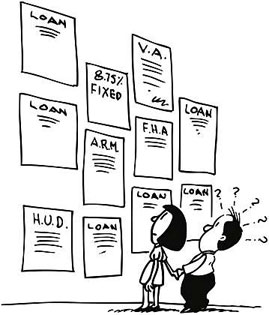
One of the byproducts of rising housing prices is the fact that government agencies and GSE’s (government sponsored enterprises) have had to keep pace too. The conforming loan limits are based on federal data on mean (average) home prices from the Office of Federal Housing Enterprise Oversight (OFHEO). Starting with Fannie Mae in November and Freddie Mac in January, all have changed their loan limits to be in compliance. Mortgage rates and options are more less expensive with a conforming loan (under the loan limit).
Here’s my question:
If the loan limit is raised to keep pace with the market, why would [Fannie Mae state in their press release](http://www.fanniemae.com/newsreleases/2005/3649.jhtml?p=Media&s=News+Releases) that this could add as many as an additional 466,326 homeowners who would be eligible for a conforming loan?
Doesn’t that imply a higher tolerance of risk for the federal government? Since the OFHEO increases are based on market data [(well not really) [Matrix]](http://matrix.millersamuelv2.wpenginepowered.com/?p=95), then the limit should rise and fall with the market. If more people qualify because of the increase, then wouldn’t the increase have to outpace the market? Hmmm, I’ll have to chart this one – more to follow.
Here’s the summary of each of the main 4 agencies or GSE’s that the OFHEO affected:
Fannie Mae[2006 Single-Family Mortgage Loan Limits [FNMA]](http://www.fanniemae.com/aboutfm/loanlimits.jhtml?p=About+Fannie+Mae&s=Loan+Limits)
Single-Family Mortgage Loan Limits effective January 1, 2006:
First mortgages
One-family loans: $417,000
Two-family loans: $533,850
Three-family loans: $645,300
Four-family loans: $801,950
Note: One- to four- family mortgages in Alaska, Hawaii, Guam, and the U.S. Virgin Islands are 50 percent higher than the limits for the rest of the country.
Second mortgages
$208,500 In Alaska, Hawaii, Guam, and the U.S. Virgin Islands: $312,750
Freddie Mac[Freddie Raises Loan Limits [OT]](http://originatortimes.com/content/templates/standard.aspx?articleid=1600&zoneid=5)
“Freddie Mac announced it will implement an increase in its single-family mortgage loan limit from $359,650 to $417,000 effective January 1, 2006. This increase in conforming loan limits is based on the October-to-October changes in the average house prices, as published by the Federal Housing Finance Board (FHFB), and on Supervisory Guidance issued by the Office of Federal Housing Enterprise Oversight. The FHFB figures come from its monthly survey of lenders. Both new and existing homes are included in the survey.”
Veterans Adminstration[VA Loan Lending Limits [VA]](http://www.valoans.com/va_facts_limits.cfm)
“The Veterans Benefits Act of 2004 was signed by the President on December 10, 2004. The law changes the maximum guaranty amount of $60,000, for certain loans in excess of $144,000, to an amount equal to 25 percent of t he Freddie Mac conforming loan limit determined under section 305(a)(2) of the Federal Home Loan Mortgage Corporation Act for a single family residence, as adjusted for the year involved.
To illustrate, the maximum guaranty for 2006 would be $104,250. This is for 25 percent of the 2006 Freddie Mac conforming loan limit for a single family residence of $417,000.”
HUD[HUD Announces Higher Loan Limits For 2006 [Originator Times]](http://originatortimes.com/content/templates/standard.aspx?articleid=1648&zoneid=5)
“Effective January 1, 2006, FHA will insure single-family home mortgages up to $200,160 in standard areas and up to $362,790 in high cost areas. The high cost amount is almost $50,000 more than last year. The loan limits for two-, three- and four-unit dwellings also increased.”
“The new loan limits are part of an annual adjustment HUD makes to account for rising home prices. Under federal law, loan limits are tied to the conforming loan limits of Freddie Mac and Fannie Mae, federally chartered corporations that buy and package mortgages.”
“Higher FHA loan limits don’t cost the government any money, because the FHA Insurance Fund is fully supported by premiums paid by borrowers who receive FHA insurance.”

